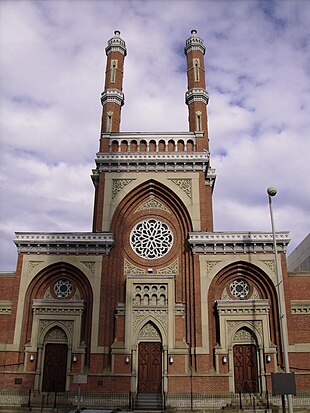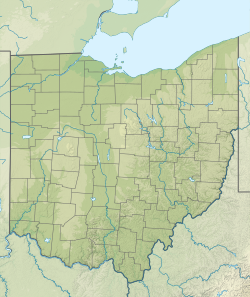
Back معبد اسحاق م. وايز ARZ Isaac M. Wise Temple Finnish Isaac M. Wise Temple French Sinagoga Isaac M. Wise di Cincinnati Italian プラム・ストリート寺院 Japanese 艾萨克·梅耶·怀斯会堂 Chinese
| Isaac M. Wise Temple | |
|---|---|
 The Isaac M. Wise Temple, in 2006 | |
| Religion | |
| Affiliation | Reform Judaism |
| Ecclesiastical or organisational status | Synagogue |
| Leadership |
|
| Status | Active |
| Location | |
| Location | Plum Street:
|
| Country | United States |
Location in Ohio | |
| Geographic coordinates | 39°6′13″N 84°31′5″W / 39.10361°N 84.51806°W (Plum Street) |
| Architecture | |
| Architect(s) | James Keys Wilson |
| Type | Synagogue architecture |
| Style | |
| Date established | 1841 (as a congregation) |
| Completed | 1866 |
| Construction cost | $275,000 |
| Minaret(s) | Two |
| Website | |
| wisetemple | |
Plum Street Temple | |
 Early 20th century photo of the Plum Street Temple | |
| Area | less than one acre |
| NRHP reference No. | 72001021 |
| Significant dates | |
| Added to NRHP | December 27, 1972 |
| Designated NHL | May 15, 1975 |
| [1][2] | |
The Isaac M. Wise Temple (formerly the Plum Street Temple), commonly called the Wise Temple, is an historic Reform Jewish congregation and synagogue located in Cincinnati, Ohio, in the United States. The congregation's historic Plum Street temple was erected in honour of Rabbi Isaac Mayer Wise, who was among the founders of Reform Judaism in the United States. The temple building was designed by prominent Cincinnati architect James Keys Wilson and its design was inspired by the Alhambra at Granada.[3]
The temple is located at 720 Plum Street in Cincinnati and was built chiefly during the Civil War at a cost of $275,000 by members of the Lodge Street Synagogue.[4] The temple was dedicated on Friday, August 24, 1866, and is among the oldest synagogue buildings in the United States.[5] The temple is across Plum Street from the historic Saint Peter In Chains Cathedral and next to the site of the former St. Paul Episcopal Cathedral, which was demolished in 1937. In 1972, the Plum Street Temple was placed on the National Register of Historic Places, and it was designated a National Historic Landmark in 1975 for its architecture and its role in the Reform movement.[2]
In 1976, the congregation expanded its facilities to include a new synagogue, community center, and school located in Amberley Village.
- ^ "National Register Information System". National Register of Historic Places. National Park Service. January 23, 2007.
- ^ a b "NHL nomination for Plum Street Temple". National Park Service. Retrieved March 20, 2018.
- ^ Kenny, Daniel (1875). "Illustrated Cincinnati". Stevens. p. 106. Retrieved May 19, 2013 – via Google Books.
- ^ Kenny, Daniel J. (1895). "Illustrated Guide to Cincinnati and the World's Columbian Exposition". R. Clarke. p. 124. Retrieved May 22, 2013.
- ^ Gordon, Mark W. (1996). "Rediscovering Jewish Infrastructure: Update on United States Nineteenth Century Synagogues". American Jewish History. 84 (1) (2019 update ed.): 11–27.
